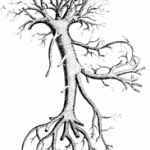Wednesday, when the Simpson’s clip was being showed, I was reminded of a clip from an episode of That 70’s Show. In the episode a group of guys go hunting. Towards the end of the episode Eric ends up in a blind alone with his father, Red, and is given the opportunity to shoot a “ten point” buck. Eric balks at the opportunity and misses the shot, and for the remainder of the time in the blind Red is giving Eric a hard time.
This clip is pretty long, and bad quality but it is all I could find of the episode. If you skip to 14:25 and watch until approximately 15:00 you’ll see Red’s reaction to finding out that Eric missed the shot on purpose. The reason I thought of this clip was because, and attached it even though the quality is kind of shitty, is because I thought it was an interesting balance to the clip from the Simpson’s. Although there is an underlying message that relates being able to fire a gun to masculinity, it shows Red respecting his sons desire to not want to kill the buck. For those unfamiliar with the show, Red’s character is considered more of a manly man. This fact, coupled with him accepting his son’s lack of desire to hunt, shows a different idea on hunting than Homer Simpson. Red is more concerned with his son being a good shot than hunting making him a man.









